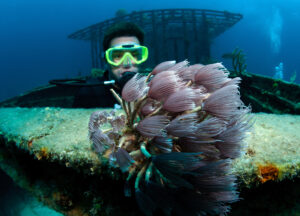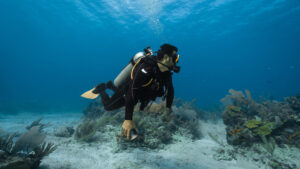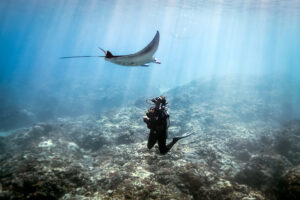What is Cave Diving?
Cave diving, a specialized form of scuba diving, involves exploring underwater environments that have overhead obstructions or enclosures such as caves, abandoned mines, quarries, natural springs, and sinkholes. Unlike open water diving, cave diving presents unique challenges due to the overhead environment, which prevents a direct vertical ascent to the surface. Consequently, it necessitates specialized training and equipment to ensure the safety and well-being of divers during their underwater expeditions.
History and Origins Cave Diving
Cave diving dates back to the 1940s, when the first documented explorations took place in Florida’s extensive underwater cave systems. Early cave divers relied on rudimentary equipment and often faced significant dangers, leading to a high rate of accidents and fatalities. Over the years, innovations in equipment, techniques, and training have vastly improved cave diving safety, transforming it into a popular adventure sport for experienced divers.
Specialized Training Required for Cave Diving
Due to the inherent risks associated with cave diving, specialized training is essential for those looking to participate in this activity. Cave diving certification courses, offered by organizations such as the National Association for Cave Diving (NACD), the Cave Diving Group (CDG), and the Global Underwater Explorers (GUE), provide divers with the necessary skills and knowledge to navigate these complex environments safely.
Training typically involves a combination of classroom instruction, confined water training, and open water dives. Key topics covered include dive planning, gas management, decompression techniques, navigation, communication, and emergency procedures. Upon successful completion of a cave diving course, divers receive certification indicating their competence in this specialized field.
Equipment Required for Cave Diving
Cave diving requires specific equipment designed to ensure the safety and efficiency of divers in overhead environments. Some essential pieces of cave diving gear include:
Redundant Air Supply
In addition to the primary air source, cave divers carry a secondary air supply in the form of an extra scuba tank or a side mount configuration. This redundancy is crucial in case of equipment failure or other emergencies.
Guideline Reels
Divers use reels to deploy a continuous guideline from the cave entrance to their furthest point of penetration, ensuring a clear path for navigation and a means of finding their way back to the exit.
Lights
Cave divers carry multiple high-powered, waterproof torches as their primary light source, with additional backup lights in case of failure.
Fins and Exposure Protection
Sturdy, durable fins are essential for cave diving, as they provide the necessary propulsion and maneuverability in tight spaces. Exposure protection, such as wetsuits or drysuits, helps maintain body temperature in the often-cold environments encountered in caves.
Safety Equipment
Cave divers must carry a variety of safety equipment, including dive computers, depth gauges, timing devices, signaling devices, and cutting tools, to ensure they are prepared for any situation that may arise.
Types of Cave Diving
Cave diving can be broadly categorized into three types based on the level of difficulty and experience required:
Basic Cavern Diving
This type of diving is suitable for beginners and entails exploring the entrance zone of a cave system, where natural light is still visible. Basic cavern diving typically does not involve penetration beyond the daylight zone.
Advanced Cavern Diving
Advanced cavern diving involves venturing deeper into the cave system, beyond the daylight zone. This type of diving requires more advanced skills, including the ability to navigate in complete darkness and manage complex gas and decompression planning.
Full Cave Diving
Full cave diving is the most advanced form of cave diving, involving penetration into extensive cave systems that may stretch for miles. It necessitates advanced training, extensive dive planning, and a high level of skill and experience.
Safety Considerations when Cave Diving
While modern cave diving techniques and equipment have significantly improved safety, the sport still involves inherent risks. Divers must approach cave diving with respect and adhere to safety guidelines to minimize potential hazards. Some key safety considerations include:
Never dive alone
Divers should always have a buddy or be part of a team to ensure mutual support in case of emergencies.
Plan the dive and dive the plan
Detailed dive planning, including gas management, decompression planning, and contingency plans, is crucial for safe cave diving.
Maintain a continuous guideline
A guideline is a diver’s lifeline, ensuring a path back to the cave entrance in case of disorientation or equipment failure.
Monitor gas consumption
Regularly checking gas levels and adhering to planned gas management protocols is essential to avoid running out of air.
Know personal limits
Divers should only undertake cave dives within their skill level and experience, gradually progressing as they gain more experience and training.
Conservation and Protection
As cave diving has gained popularity, the need for conservation and protection of these unique environments has become increasingly important. Many caves are home to fragile ecosystems and archaeological treasures that can be easily damaged or destroyed by human activity. Divers have a responsibility to adhere to strict conservation practices and minimize their impact on these sensitive habitats. Some key conservation practices include:
Good Buoyancy Control
Maintaining proper buoyancy is essential to avoid stirring up sediment, which can harm delicate cave formations and reduce visibility.
Controlled Finning Techniques
Utilizing appropriate finning techniques, such as the frog kick, helps prevent damage to the cave floor and delicate formations.
No-Touch Policy
Divers should avoid touching cave formations, as even the slightest contact can cause damage over time.
Proper Guideline Management
Ensuring guidelines are properly secured prevents them from causing damage to the cave environment.
Waste Disposal
Divers must be diligent in managing their waste and ensuring nothing is left behind in the cave.
Key Takeaways
Cave diving offers adventurous divers the opportunity to explore unique underwater environments that few have experienced. With proper training, equipment, and adherence to safety guidelines, cave diving can be an exhilarating and rewarding pursuit for those willing to accept its challenges.

















